Ancient Ships: The Ships of Antiquity
The Egyptian Galleons
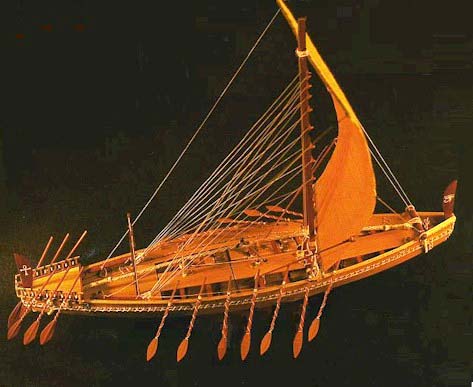
Egyptian seafaring ships from the 5th Dynasty 2458-2446 BCE
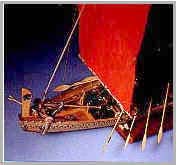 This
ship is typical of the vessels used during the reign of Pharaoh
Sahure over 4400 years ago. Egypt's expanding interests in
trade goods such as ebony, incense such as Myrh and frankincense,
gold, copper and other useful metals inspired the Egyptians to build
suitable ships for navigation of the open sea. The navy of
Sahure traded with Lebanon for cedar and traveled the length of
the Red Sea to the Kingdom of Punt, modern Ethiopia and Somalia
for ebony, ivory and aromatic resins. Ship builders of that era
did not use pegs (treenails) or metal fasteners, but relied on rope
to keep their ships assembled. Planks and the superstructure
were tightly tied and bound together with rope binders. Joints and
cracks in the superstructure were sealed with pitch and bitumen. This
ship is typical of the vessels used during the reign of Pharaoh
Sahure over 4400 years ago. Egypt's expanding interests in
trade goods such as ebony, incense such as Myrh and frankincense,
gold, copper and other useful metals inspired the Egyptians to build
suitable ships for navigation of the open sea. The navy of
Sahure traded with Lebanon for cedar and traveled the length of
the Red Sea to the Kingdom of Punt, modern Ethiopia and Somalia
for ebony, ivory and aromatic resins. Ship builders of that era
did not use pegs (treenails) or metal fasteners, but relied on rope
to keep their ships assembled. Planks and the superstructure
were tightly tied and bound together with rope binders. Joints and
cracks in the superstructure were sealed with pitch and bitumen.
Historical records show that Pharaoh Sahure
the second king of the 5th Dynasty established an Egyptian
navy and sent a fleet to Punt and traded with cultures in the Eastern
Mediterranean. His pyramid has colonnaded courts and relief sculptures
which illustrate his naval fleet and record his military career
consisting mostly of campaigns against the Libyans in the western
desert. He is credited to have begun the cemetery complex at Saqqara
and he also had a diorite quarry just west of Abu Simbel.
| Model Picture Provided By Hobby World Of Montreal
King Sahure's Ship 2458-2446 BCE 5th Dynasty |
|
King Sahure purchased cedar timbers and commissioned the ship builders
from the area of ancient city Byblos to create his ships; the importance
of the Phoenician culture in seafaring technologies and trade throughout
the eastern Mediterranean should not be underestimated. Bigger ships
of seventy to eighty tons displacement suited to long voyages became
quite common (In size they can be compared to Columbus's Santa Maria
with a displacement of 100 tons or his smaller ships with about
fifty). How and where these types of ships were used other than
the expeditions where records are available is a matter for speculation
and conjecture. The adventures of seafarers were the subject of
Egyptian literature and the story of the shipped wrecked sailor
recordered in approxiametely 2200 BCE is but one example that sheds
some light on the matter.
| Front View of Sahure's ships Circa 2500 BCE
|
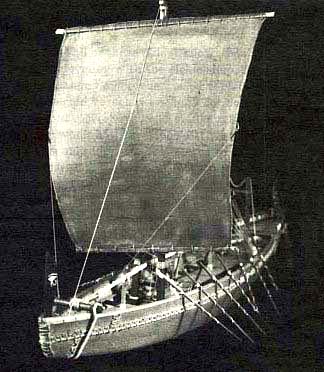 |
The next ship is a model constructed from illustrations on wall
panels at the funerary complex of Hapshetsut. One thousand years
of Egyptian history and the evolution of ship building in Egypt
separates the two ships. It is interesting to make a comparison
of the results of the shipwrights craft in the two different millennia.
Hatshepsut's ships are generally larger and more complex in their
superstructure. Most noteworthy is the fact that Sahures ship used
larger sections in their planking.
A modern model of an Egyptian sea worthy ship created
on the basis of information from the funerary temple of Hatshepsut.
This model of a 15th century BCE merchant ship was made after
the wall relief at Deir el Bahri. The ship was about 22 meters long
and 5 meters wide. It didn't have a wooden keel but got its stability
from a thick rope fastened under tension at either extremity of
the ship. There were fifteen rowing oars on either side, two connected
oars used as rudder, a single mast and a 15-meter wide horizontal
sail. The stern was decorated with a carved lotus flower. A major
expedition to the Land of Punt (probably modern day Somalia) down
the Red Sea and into the Indian Ocean was undertaken under Queen
Hatshepsut.
Another story of seafaring trade is the journey
of Wenamen in 1100 BCE, a trading expedition gone wrong in Egypt.
This story illustrates the extent to which cultures bordering the
seacoasts relied on ships and boats for their transportation and
trade. Seafaring was the cheapest and fastest means of transportation,
which meant the majority of trade was conducted by shipping by boat.
In the Eastern Mediterranean cultures generally established cities
and towns close to coastlines in order to take advantage of this
phenomenon.
Rameses III recorded
his conflict and defeat of the sea peoples at Medinet Habu. This
model of a 13th century warship was made after wall paintings at
Medinet Habu depicting the victory of Ramses III over the Sea Peoples.
The high bulwarks protected sailors and soldiers from enemy missiles.
| Egyptian Ship used during the conflict with
the Sea Peoples 1250 BCE |
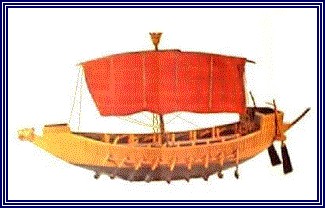 |
Eighteen oars gave it the
maneuverability, which was a decisive factor in the Egyptian victory.
Like all Egyptian ships of this period, it was not laid on a keel,
but got its structural strength from a gangway-connecting stern
to bow. It had a single mast with gangway connecting stern to bow.
The single mast was hung with a horizontal sail. The stern was decorated
with a lion's head crushing a human skull. This model of a Philistine
man of war was equally constructed according to the Medinet Habu
paintings. This is the kind of vessel the Sea Peoples would have
used in their attempt to invade Egypt in 1280 BCE. This implies
that this kind of ship may have been used and available to the entire
confederation of Sea Peoples, therefore this kind of vessel structure
may have been used throughout the Aegean and Black Sea Regions.
Its lack of rowing oars may have been a distinct disadvantage in
the confined space of the Nile delta where they must have been incapable
of using their ram against the more maneuverable Egyptian vessels.
This also indicates that this design was not created primarily for
military use. The sea people depended heavily on land forces for
the success of their military campaigns. Although not as effective
in its design for Naval battles this ships overall structural design
was superior to that of the Egyptian ships, having a proper keel
and body ribs to make the hull ridged.
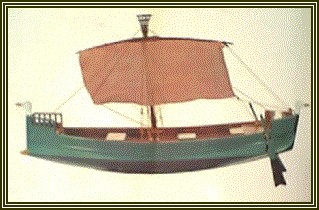 |
Modern model of a ship of the sea peoples
created after the illustrations on wall panels at Mendinet Habu.
Circa 1250 BCE . The model is at the Haifa Naval Museum, Israel. |
Previous |
Next
| Table Of Contents

|
